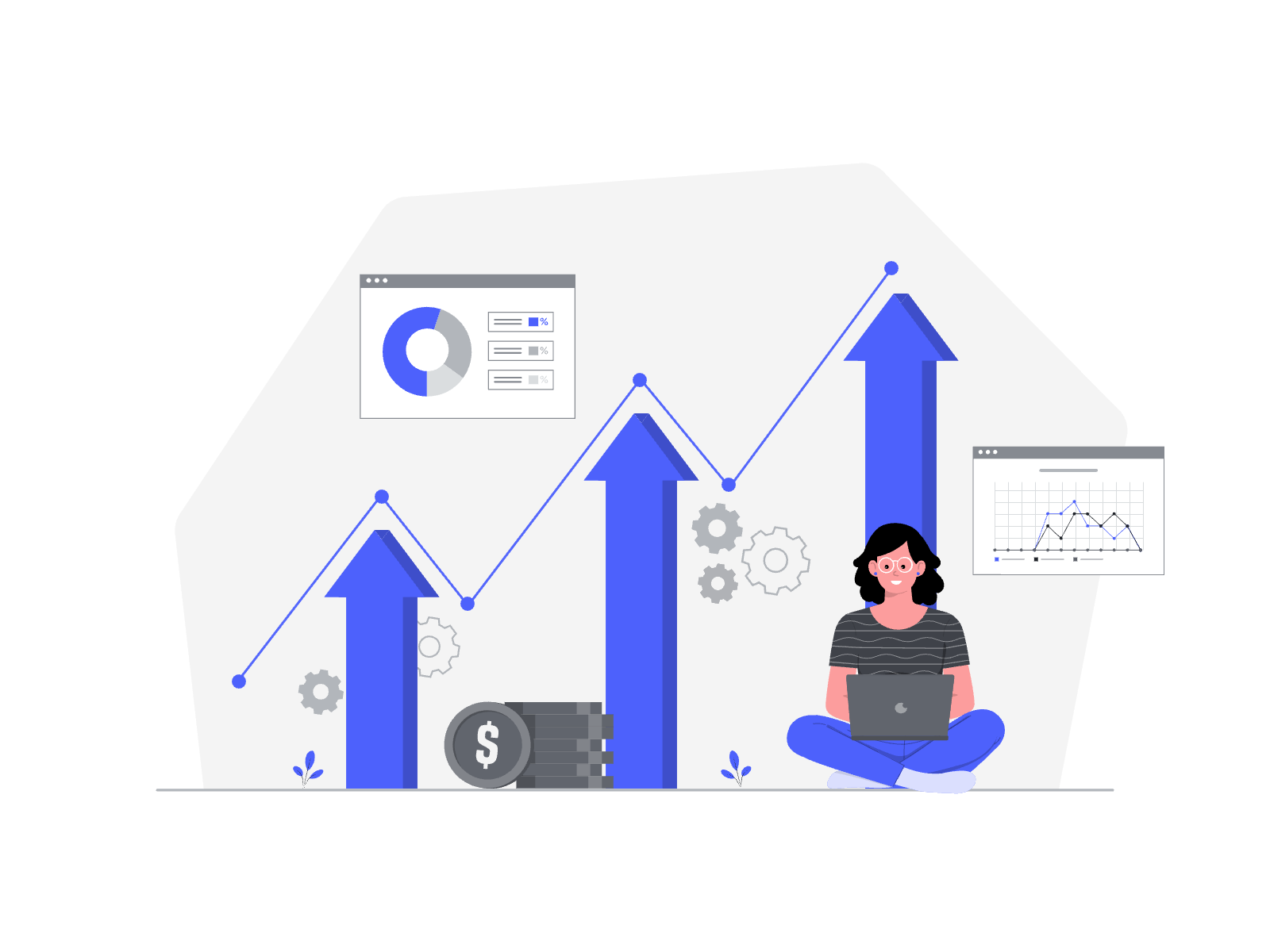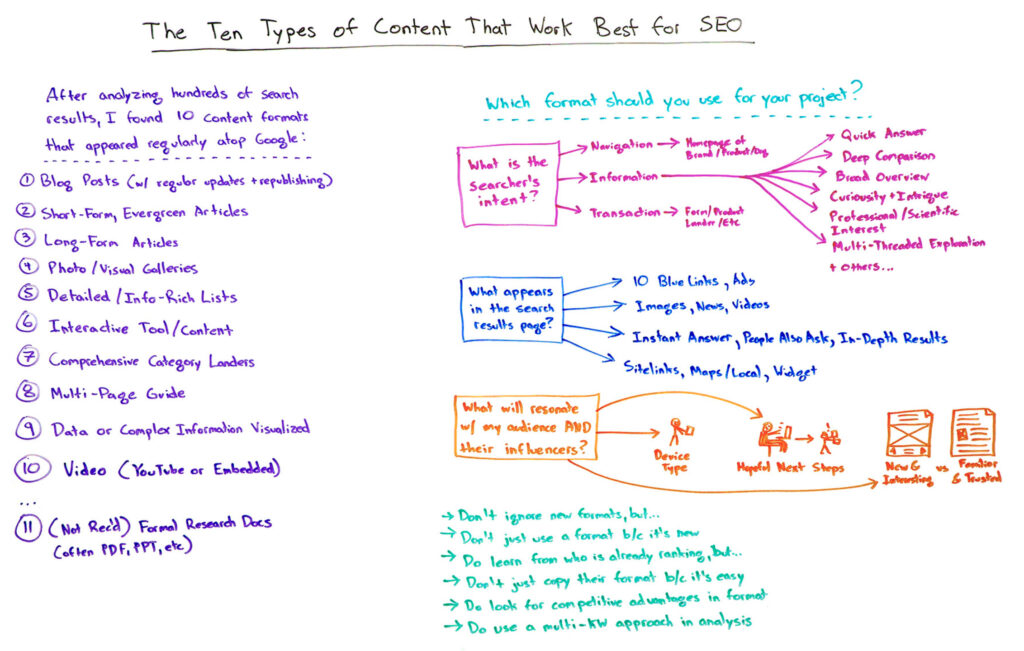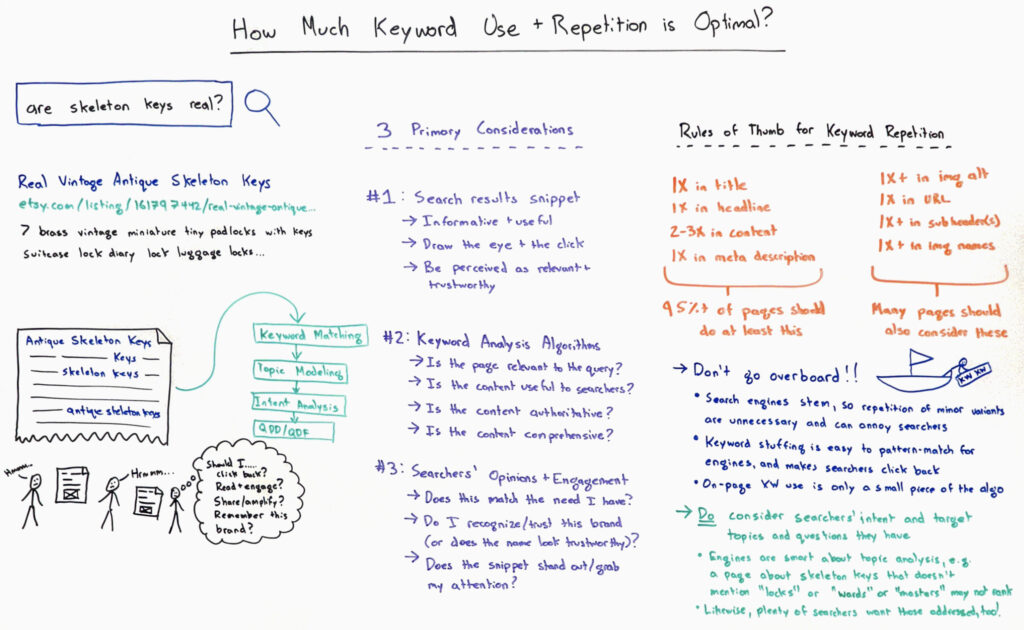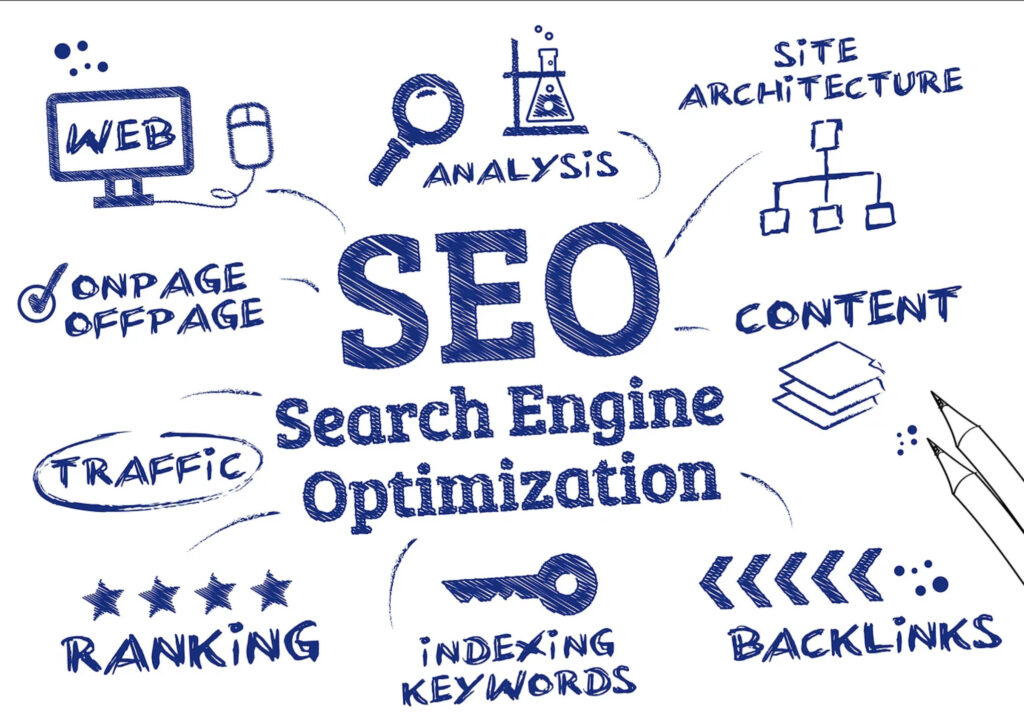Summary: This is part 2 of a content based step-by-step approach that can help you rank on the first page of Google. Here we go deeper into how to create the content for which we have shortlisted keywords and also touch upon some hygiene stuff.
This blog is inspired by my time at TravelTriangle and how we were successful in SEO via content approach in the travel industry. You can read the part 1 here.
Step 2: Creating Content
Once you have decided on a keyword, determine which type of content will be effective. As we discussed in Part 1, Google itself provides guidance on which format to use, such as blogs, listicles, videos, and so on. It’s important to remember that there isn’t a one-size-fits-all approach, and contrary to popular belief:
- Not every blog needs images.
- Not all content should be long-form.
- Listicles may not be suitable for every query.
Do what is best for the user (but don’t ignore Google). Always, map user intent to content form. Image below is a good list of various content forms and when can they be used.
To make the process repeatable for your team, follow my framework below to narrow down user intent, language, and keywords without losing meaning.
Framework For User Intent
Irrespective of the content form you chose, you can use the following framework to help you narrow down the content.
For your keyword define the following:
- Who is the primary user and/or secondary user?
- What is the user’s intent when searching for this keyword?
- What other questions might the user ask or think about while exploring this topic?
- What kind of experiences, semantics, and language would the user expect in content related to this topic?
- What is the next action the user might take after reading the content?
- What external validations will the user seek to confirm the information presented?
By addressing these points, you’ll be able to create content that effectively caters to your target audience and addresses their needs throughout the user journey.
Below example shows how we would use it in practise for keyword: Honeymoon places in India
- Who is the primary user and/or secondary user?
- Engaged individuals and their fiancés, mid-funnel, destination undecided.
- Engaged individuals and their fiancés, mid-funnel, destination undecided.
- What is the user’s intent with this search?
- Compare various honeymoon destinations in India based on attributes such as budget, season, unique features, and types of experiences.
- Compare various honeymoon destinations in India based on attributes such as budget, season, unique features, and types of experiences.
- What other questions might the user ask or think about while exploring this topic?
- What is the best time to visit Kerala for a honeymoon? What will the airfare be like?
- What is the best time to visit Kerala for a honeymoon? What will the airfare be like?
- What semantics/language/experiences does the user seek?
- Romantic, newlywed, soon-to-be-married, candlelight dinners, couples, and other related terms.
- Romantic, newlywed, soon-to-be-married, candlelight dinners, couples, and other related terms.
- What will be the next action the user takes after reading this?
- Perhaps read more about honeymoon experiences in specific destinations, such as Kerala.
- Perhaps read more about honeymoon experiences in specific destinations, such as Kerala.
- What external validations will the user seek, and are they needed?
- The user may seek reviews or recommendations from sources like TripAdvisor or Lonely Planet to validate their choices.
Language & Keywords
- It’s crucial to use appropriate language in your content. As a thumb rule, avoid marketing language and focus on transactional, factual, and conversational language instead.
- Refrain from using unnecessary adjectives. Present facts in an engaging and creative manner while keeping redundancy to a minimum. For example, avoid phrases like “Walking on Kerala beaches feels like walking on 7th heaven.”
- Wikipedia ranks highly in SERPs for various reasons, including effective structuring and formatting of information.
- Proper language use and logical structuring/formatting of information are essential.
- Keywords still play an important role, unfortunately.
- In addition to the primary keyword you’re targeting, define secondary keywords as well. Establish synonym sets (for this keyword and user intent) and determine the appropriate semantics for the topic.
- Focus on the language that users commonly use or prefer to use in conversation.
- Assume that Google understands the topic better than you do. Create synonym sets and semantic text that relates to the topic and helps improve search rankings.
Keyword Density & Placment
- Keyword density and placement remain crucial factors in SEO.
- Use natural, conversational, and factual language with correct grammar and logical structure, while incorporating keywords naturally.
- Include the primary keyword in the H1 tag, URL, and within the first 50-60 words of the blog.
- Avoid overly long headlines; for short headlines, add secondary keywords or make them more experiential.
- Distribute keyword placement throughout the content, including primary keywords and variations in H2 tags.
- Use H1, H2, H3, H4, etc., tags wisely, as Google favors consistency.
- Optimize for mobile by using bullet points (<li>) and incorporating keywords within them.
- For images, include the keyword in the alt text and use natural language that describes the image in its specific context.
- As an example, check out this page for Driving License in Gurgaon. (While I don’t recommend that you do similar to them, but I am trying to share how important some of these things are.)
Effective Internal & External Linking
- Practice strategic interlinking by only linking to relevant blogs within your content.
- Use rich anchor text that accurately describes the linked blog.
- Ensure links are contextually appropriate and relate to the user’s intended action.
- For external links, consider using the rel=nofollow tag and, if possible, avoid including them.
- If providing external links, prioritize linking to authentic or popular domains over newer ones.
- Encourage users to visit the suggested websites, preventing them from returning to Google for additional searches.
Formatting & Additional Tips
- Formatting is crucial as it contributes to a positive user experience, which Google appreciates.
- Use formatting to emphasize essential parts of the text, including keywords where appropriate.
- Experiment with plugins on WordPress or your CMS that can enhance SEO without affecting site speed (e.g., Playbuzz and other WordPress plugins).
- For topics like “before and after wedding photos,” consider using interactive plugins such as flip plugins to increase user engagement.
- Utilize multipage content to pique user curiosity and encourage them to visit multiple pages, improving overall SEO health.
- In certain categories, video aggregated blogs can be highly effective—optimize YouTube videos and contextually include them in your content.
- Actively encourage and respond to comments, signaling to Google that your page has rich activity.
- Periodically refurbish blogs by adding relevant new content or updating the publish date, ensuring your content stays fresh and up-to-date.
Step3: Hygiene & Other Important Tips
Before hitting publish, ensure you’ve covered the other essential SEO factors to increase your chances of success.
Meta Tags
- Ensure meta titles and descriptions are well-crafted and include your primary keywords.
- Recommended meta title length: 30-65 characters.
- Recommended meta description length: 70-200 characters.
Techincal Aspects
- Use a subfolder for your blog instead of a subdomain on your parent website.
- Prevent indexing of non-essential items like tags from your sitemap.
- Implement lazy-loading for images to reduce page load times.
- Add alt descriptions to every image on your site.
- Make sure your site displays correctly on mobile devices and tablets.
- Check for broken links and fix them.
- Ensure a “robots.txt” file is present and google bot is allowed to index.
- Verify that an HTTPS certificate is present and properly configured.
- Confirm Privacy / Terms and Conditions / Cookies policy pages are present.
Content Distribution
- Promote your blog to seed initial traffic, using both paid and non-paid channels.
- Ensure your blog is shareable on social media platforms, as social signals matter.
- Submit your content to multiple search engines, including Google.
- Regularly check if others have copied your blog and, if so, request a dofollow link or reference from their site.
- Focus on both content creation and distribution to maximize reach.
Concluding Remarks
In conclusion, while we have covered content-based SEO strategies in depth, it is important to remember that SEO is a continually evolving field. Google frequently updates its algorithm, requiring us to adapt and refine our understanding and approach. Beyond content-based SEO, there are many other factors to consider, such as technical SEO and off-page SEO, which play significant roles in achieving high search engine rankings.
As you embark on your SEO journey, keep learning, stay up-to-date with the latest best practices, and be prepared to adapt to the ever-changing digital landscape. Remember, success in SEO is a long-term endeavor, so remain patient and persistent in your efforts.
Please feel free to leave comments below or reach out to me here to discuss further.










Very well articulated.